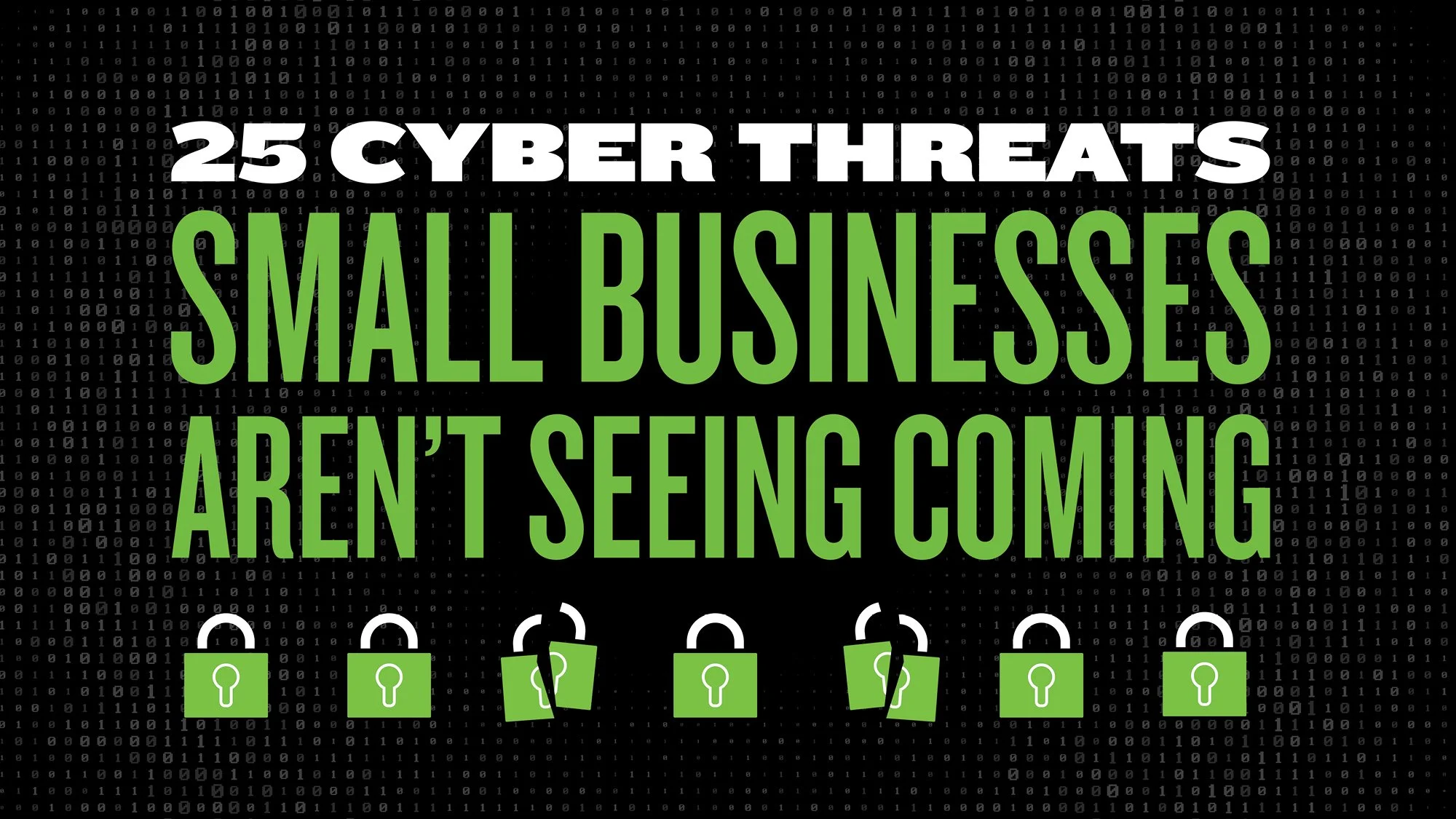2025 Cyber Threats Small Businesses Aren’t Seeing Coming
Executive summary (for busy leaders)
SMBs are getting hit by session hijacks, malicious OAuth app consents, QR-invoice scams, deepfake voice approvals, legit remote-tool abuse, and MFA push fatigue. These aren’t “future” threats—they’re happening now because identity, browsers, and SaaS are today’s perimeter. This article explains each tactic in plain English and closes with a 30-day checklist any small team can execute. We are also hosting a webinar highlighting the biggest Cybersecurity threats we are seeing right now, you can register for that here.
What changed—and why it matters
The security model quietly shifted. Passwordless logins, AI helpers, and a sprawl of cloud apps created new doors. Attackers don’t need your password if they can steal your active session, convince staff to grant an app “read/write mail”, or clone a voice to rush approvals. The impact is concrete: downtime, wire fraud, data exposure, insurance scrutiny, and vendor risk. The fix is leadership choices plus a handful of high-impact settings—not a giant new budget.
The threats you’re likely underestimating
1. Session-token theft (adversary-in-the-browser)
The play: After you sign in with MFA, the browser stores a token so you stay logged in. Attackers steal that token to impersonate you—no password needed.
Why SMBs feel it: Long-lived sessions, unmanaged browsers, and “keep me signed in” everywhere.
What to do now: Shorten session lifetimes, require step-up auth for admin/billing, block legacy authentication, and bind sessions to managed/enrolled devices.
2. Consent phishing & malicious OAuth apps
The play: A clean “Sign in with Microsoft/Google” screen asks for permission. One click, and a third-party app gets mail/files access.
Why SMBs feel it: Helpful automation tools + no app governance + “approve to proceed” fatigue.
What to do now: Turn on admin-only consent, stand up an approved-app catalog, and remove stale or high-scope grants (e.g., Mail.ReadWrite, Drive full access).
3. QR-code and invoice switch-ups
The play: Payment changes or fake portals arrive as calendar invites, doc comments, or QR codes on scanned invoices. Email filters don’t always catch it.
Why SMBs feel it: Finance works across channels and QR looks harmless.
What to do now: “No QR for payables,” two-channel verification for vendor changes (call a known number on file), and enable link/QR inspection if available.
4. Deepfake voice approvals
The play: A cloned executive or vendor voice demands urgent payment or a password reset.
Why SMBs feel it: Verbal approvals and fast-moving teams.
What to do now: Eliminate verbal-only approvals. Require a second factor (code in Teams/Slack or a pre-shared passphrase) and add after-hours “delay rules.”
5. Remote-tool abuse that looks like IT
The play: Attackers install or piggyback on common remote-support tools, then move laterally—everything looks normal.
Why SMBs feel it: Multiple overlapping tools and standing local admin.
What to do now: Standardize on one remote tool, block/alert on others via EDR/app control, remove standing local admin, and use just-in-time elevation.
6. MFA push fatigue
The play: Bombard users with prompts until they tap “approve.”
Why SMBs feel it: Push-only MFA without number matching or rate limits.
What to do now: Prefer phishing-resistant MFA (hardware keys or passkeys), enable number-matching, and throttle push attempts.
Biggest protection per dollar (shortlist)
Phishing-resistant MFA for privileged + finance roles (hardware keys or platform passkeys).
Identity risk monitoring (risky sign-ins/session anomalies) with someone actively looking and responding.
Admin consent + SaaS governance—kill OAuth backdoors and publish an approved-app catalog.
Conditional access baselines—block legacy auth; require compliant/enrolled device for admin roles.
AP anti-fraud workflow—two-channel verification and a “no QR for payables” policy.
The 30-day hardening plan
Week 1 — Identity & sessions
Shorten session lifetimes; require step-up for admin/billing actions.
Block legacy auth; enable device compliance for privileged roles.
Turn on alerts for impossible travel, token anomalies, and atypical consent.
Week 2 — SaaS consent hygiene
Switch to admin-only consent; document an app approval process.
Review & remove high-scope or stale OAuth grants.
Publish a simple Approved Apps list by department.
Week 3 — Finance controls
Two-channel verification for vendor changes and payments > $X.
After-hours “delay rule” for urgent requests.
Update SOP: no QR codes for payment instructions; use vendor portal bookmarks.
Week 4 — Remote access & detection
Standardize on one remote tool; block/alert on others via EDR.
Remove standing local admin; adopt just-in-time elevation.
Run a tabletop: simulate a session hijack → revoke tokens, review app grants, reset creds, confirm containment.
How to measure progress
Identity risk score trends down; fewer risky sign-ins/session anomalies.
OAuth app count stabilizes; only named systems retain high-scope permissions.
AP exceptions decline; vendor changes pass two-channel checks.
EDR alerts for unapproved remote tools approach zero.
Mean time to revoke sessions < 15 minutes.
FAQs leaders ask
Will this slow people down? A few seconds at sign-in or for high-risk actions, in exchange for avoiding week-long outages or six-figure fraud.
Do we need a new toolset? Start with settings you already own, then add targeted capabilities (keys, IDR) where they reduce loss fastest.
How do we keep it from backsliding? Document “Security Defaults,” add them to onboarding/offboarding, and review quarterly.
Implementation tips
Treat this as an operations change, not a “security project.” Give it an owner, a deadline, and a success metric.
Communicate why each change exists (“seconds now to avoid days later”).
Pilot with finance + admins first; expand once stable.
Interested in learning more?
Check out our webinar page to sign up for our upcoming webinars or watch a recording after the event.
Have additional questions? Check out our comprehensive frequently asked questions page here to find an answer.
Get in touch with us over at our contact page, We’d love to help!

